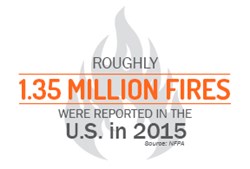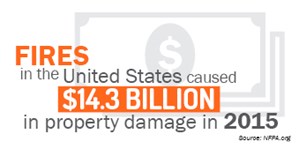Fire Safety Procedures
03
February,
2023
4 MINUTE READ

Fire safety is a top concern for large and small businesses alike. According to the NFPA, approximately 13.5 million fires were reported in the United States in 2015, causing $14.3 billion in property damage. As such, it's important that employers and building maintenance managers prepare for fires-and have plans for what to do if a fire breaks out.
Fire safety procedures are a written set of plans describing the actions to be taken in the event of a fire emergency, and assigning responsibility for each action. Each set of plans needs to be customized; the recommended actions and responsibilities will be different depending on the facility, the type of work being done there, the types of materials used, and the people present.
Having effective fire safety procedures and proper employee training will reduce the injuries and damage caused by a fire. If there are no fire safety procedures, or if the procedures are poorly prepared or poorly tailored to the facility, the likely result will be a disorganized evacuation or emergency response, leading to confusion, injury, and increased property damage.
OSHA Requirements for Fire Safety Procedures
There is only one OSHA regulation that specifically requires fire safety procedures: 29 CFR 1915.502 - Fire Protection in Shipyard Employment, Fire Safety Plan. This OSHA standard addresses the establishment of a fire safety plan in shipyards, but it also includes a "Model Fire Safety Plan" that can be used as a generic outline for establishing fire safety procedures in any type of facility.
More commonly, OSHA requires facilities to have written Emergency Action Plans. These formal plans incorporate fire safety procedures, as well as procedures and actions to be taken in response to other types of emergencies. However, OSHA only requires that an emergency action plan be in place when certain conditions exist, such as the following:
- Process Safety Management of Highly Hazardous Chemicals, 1910.119
- Fixed Extinguishing Systems, General, 1910.160 (When the extinguishing system could pose a significant health hazard)
- Fire Detection Systems, 1910.164 (When fire detector actuation is delayed more than 30 seconds)
- Grain Handling, 1910.272
- Ethylene Oxide, 1910.1047
- Methylenedianiline, 1910.1050
- 1,3 Butadiene, 1910.1051
Even if OSHA doesn't require your facility to have an emergency action plan, it is a good practice to establish fire safety procedures.
Gathering Information: The Fire Risk Assessment

The first step in creating facility-specific fire safety procedures is to conduct a Fire Risk Assessment. It is impossible to make an effective and comprehensive plan without the necessary information; an assessment will provide the details that you need. Here's a look at what a risk assessment should cover:
- Identification of hazards
- Sources of ignition
- Identification of persons at risk from fire
- Means of escape from the building
- Fire warning systems
- Fire-fighting facilities
- Identification of fire safety procedures
- Review of the controls in place and recommendations for improvements where necessary
Creating Your Fire Safety Procedures
After collecting information through a Fire Risk Assessment, you can use that knowledge to describe the best ways for employees to respond to a fire alarm or fire emergency. These procedures should take into account your specific worksite layout, the building's structural features, and the existing fire emergency systems.
The OSHA requirements for an emergency action plan form a useful guide for the creation of fire safety procedures. Following that lead, your procedures should:
- Describe what to do when a fire is discovered.
- Establish routes and procedures to be followed for evacuations.
- Establish areas of refuge and specific plans for evacuating those areas of refuge.
- Provide procedures for evacuating disabled employees.
- Establish a system to account for all evacuated employees.
- Establish conditions and processes under which employees will fight a fire (if any.)
- Require appropriate firefighting training.
- Require the placement of any necessary firefighting equipment.
- Establish procedures for the shutdown of critical plant equipment, and provide for the evacuation of any employees who stay behind for such shutdowns.
- Identify the preferred methods for alerting employees to a fire emergency.
- Require a working alarm system to be present throughout the workplace.
The Fire Safety Procedures must be combined with employee training. Employees need to know what they are supposed to do should there be a fire emergency, even if their only task is to get themselves out of the building. All new employees should be familiarized with the fire safety procedures, and existing employees should have periodic retraining-especially if the procedures are changed. The entire set of fire safety procedures should be kept available for employee review.
Should Fire Safety Procedures Include Portable Fire Extinguishers?
OSHA does not require the use of portable fire extinguishers. The best course of action in a fire emergency is usually to evacuate the building, and let professional firefighters control the fire. However, if there are circumstances in which you want employees to use portable fire extinguishers, those situations must be detailed in your fire safety procedures, and you must provide hands-on training in using the extinguishers. For more information on OSHA's fire protection rules, see 29 CFR part 1910, subpart L.
Fire Safety Procedures for Evacuations

Getting everyone safely out of the building is a major part of good fire safety procedures. OSHA requires that every workplace has enough emergency exits and that the exits are suitably located to enable everyone to get out of the building quickly. There are many factors that are considered in deciding the number and location of emergency fire exits: the type of structure, the number of persons exposed, the type and extent of the fire protection available in the building, the type of industry involved, and the height and type of construction of the building. These exits will not help in an emergency if they are blocked, locked, or unknown, though.
The fire safety procedures should designate preferred exit routes, as well as secondary exit routes in case the normal exit routes are blocked. Evacuation assembly points should be established so everyone knows where they are to go during an evacuation, and so those who have successfully evacuated can be identified.
Gathering Information: the Fire Risk Assessment
The first step in creating facility-specific fire safety procedures is to conduct a Fire Risk Assessment. It is impossible to make an effective and comprehensive plan without the necessary information; an assessment will provide the details that you need.
RELATED RESOURCES

Understanding OSHA's 1910 120 (HAZWOPER) Requirements
OSHA is not involved in regulating hazardous waste. However, they are concerned about the safety of workers ...
Read
Types of Floor Marking
As workplaces grow increasingly sophisticated, it's imperative that employers keep workers safe, increase ...
Read
What Is OSHA 10? | OSHA 10 Certification |
The term OSHA 10 refers to the OSHA Ten Hour Training that is part of the OSHA Outreach Training Program. The ...
Read.png)


